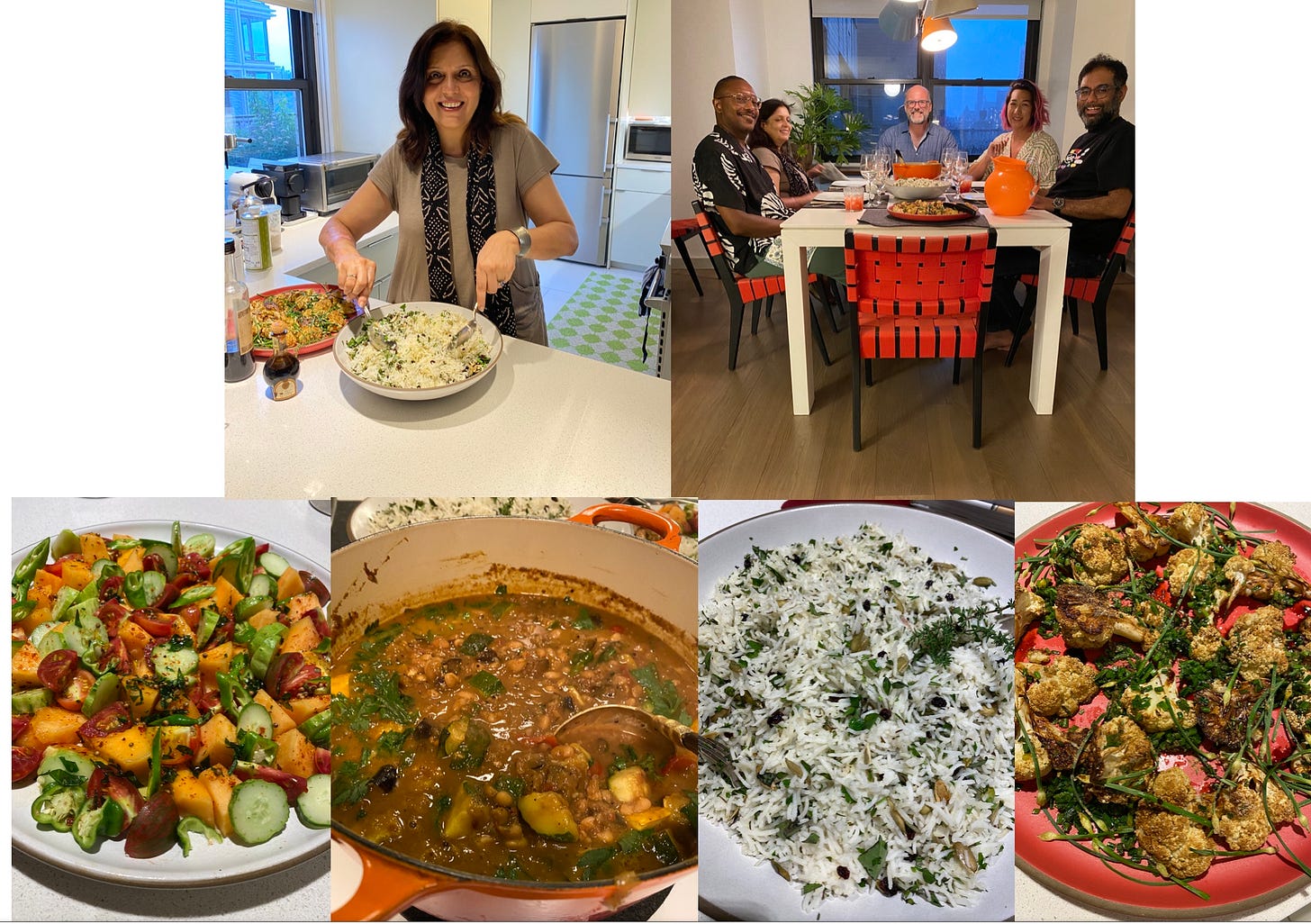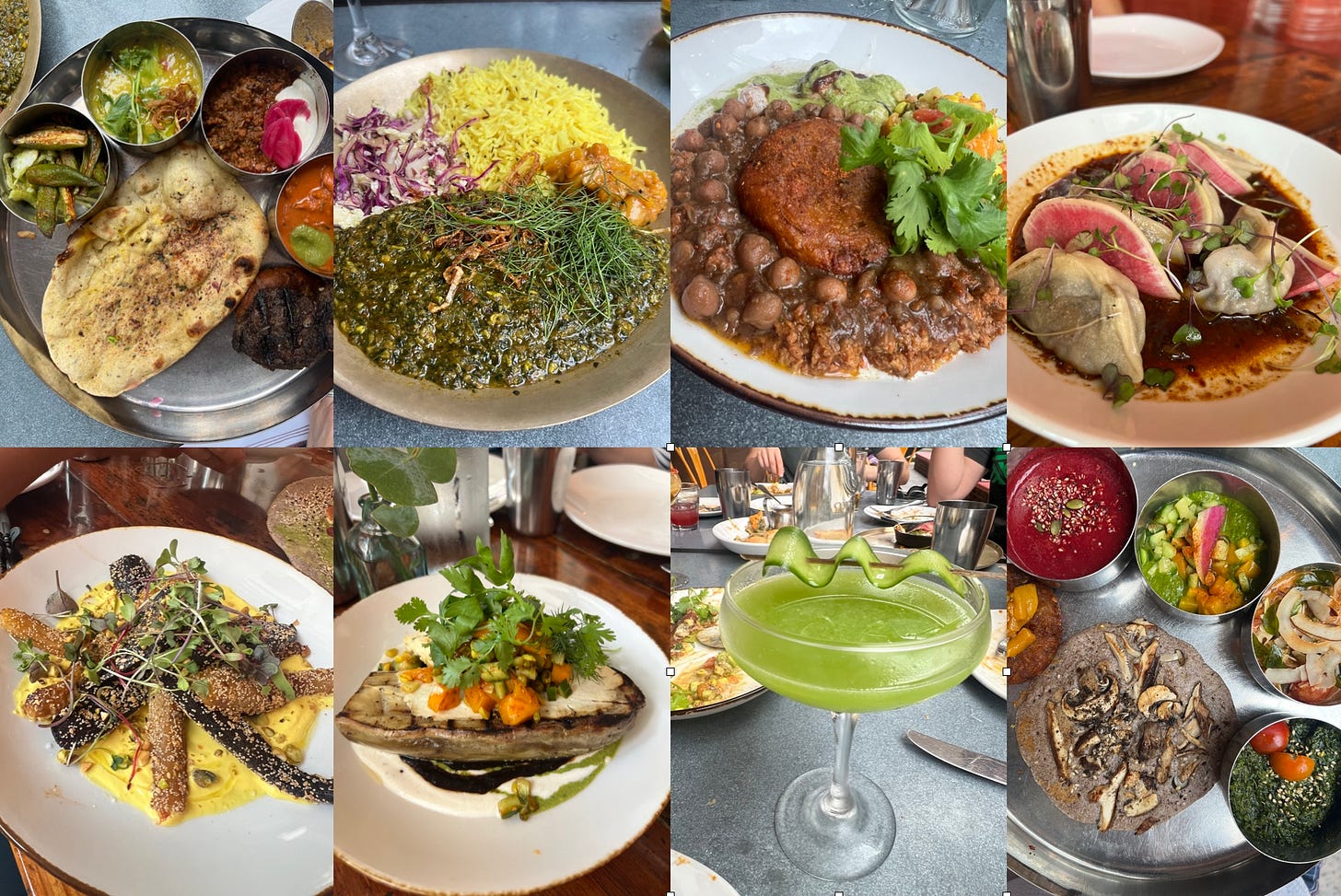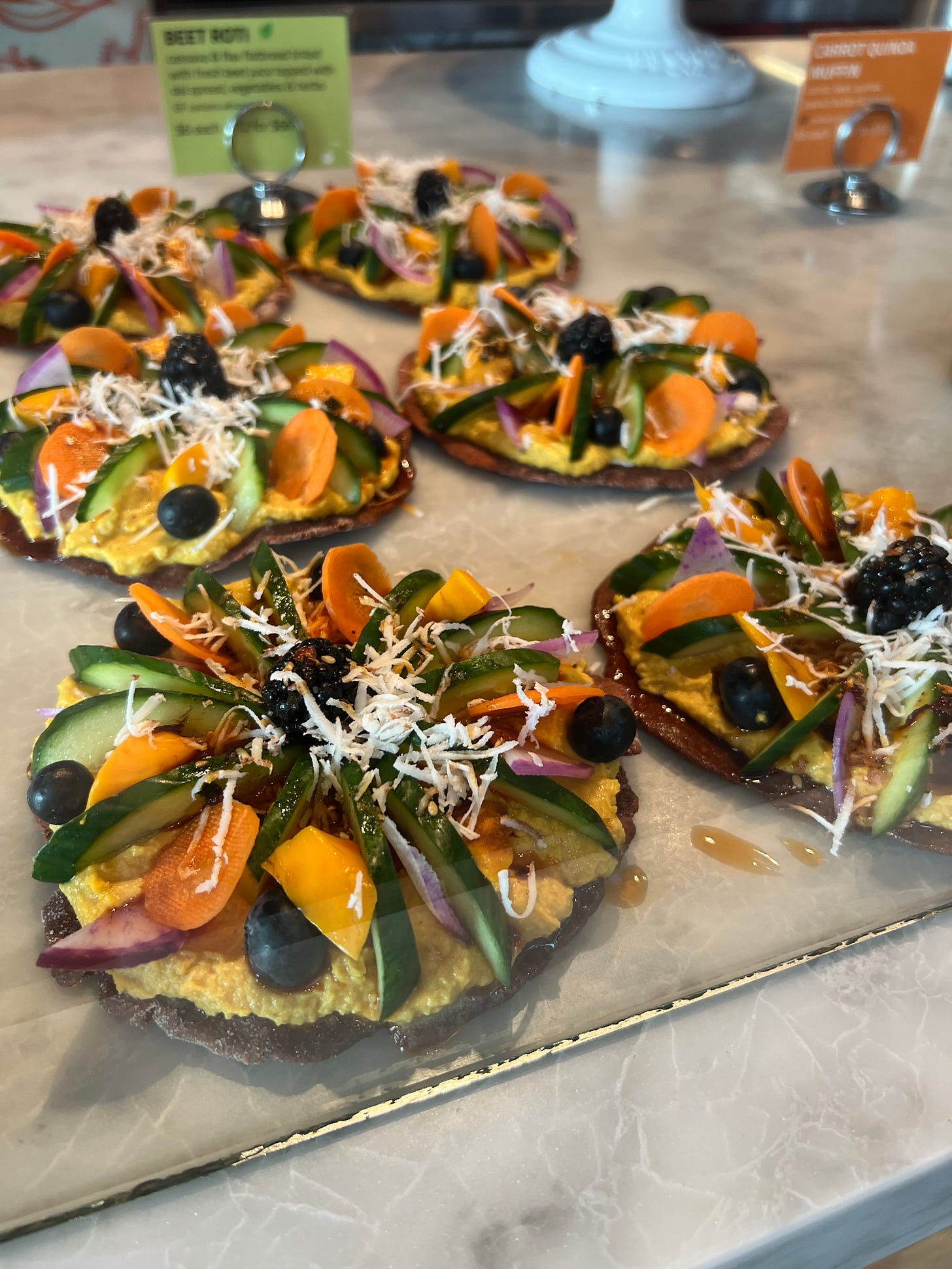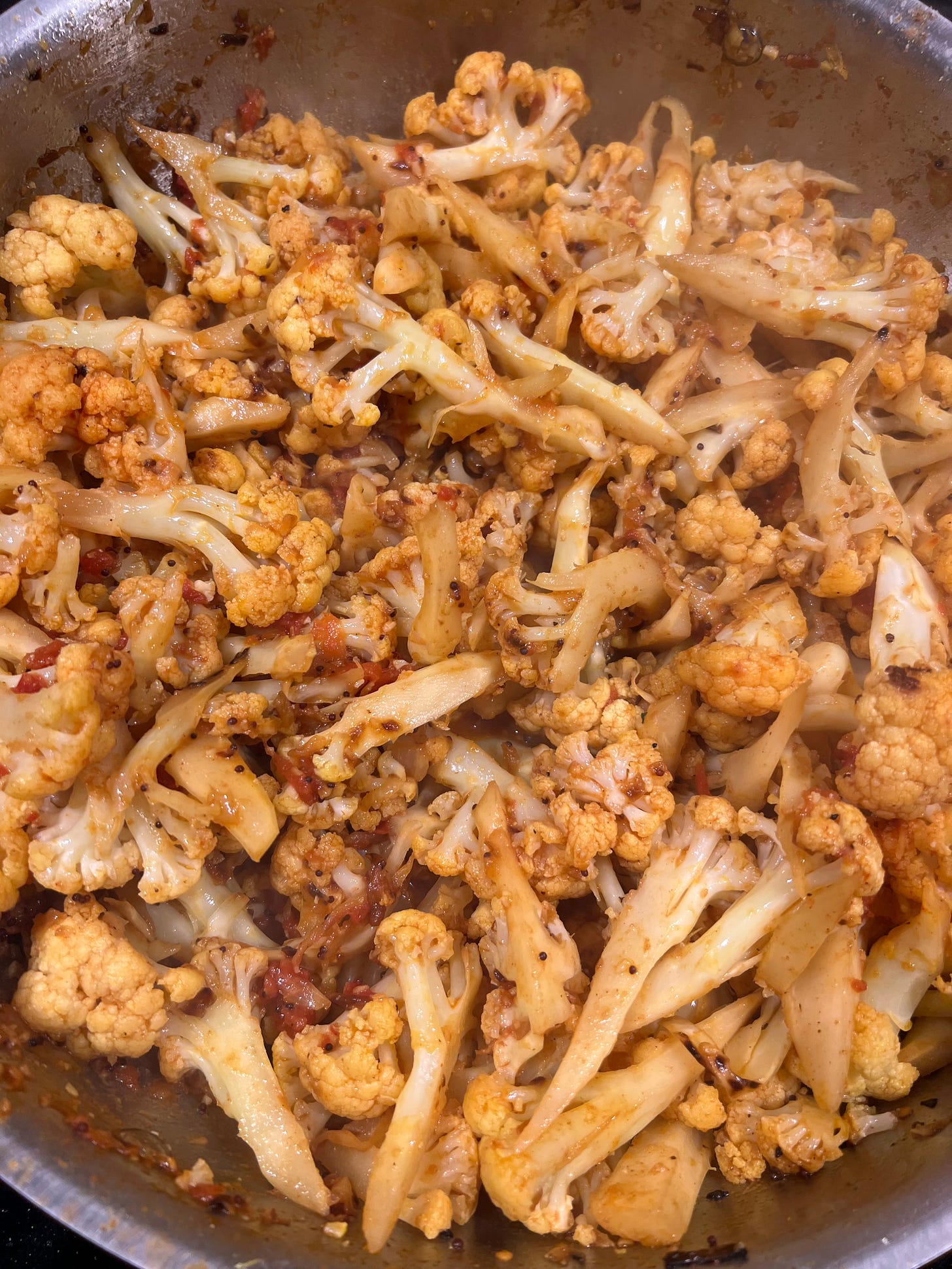Issue #157: Punjabi Cauliflower
Houston, You Have Pondicheri, Anita's POV, Spicy Cauliflower with Tomato
Although I’m writing this newsletter from Las Vegas, where I’ve come for the World’s 50 Best Restaurants awards festivities and the inaugural Wynn Revelry food festival, both of which I’ve helped curate, on my way here I stopped for a few days in Houston.
For the last few months, I have also been working with Anita Jaisinghani and her team at Houston’s beloved Pondicheri Restaurant and Bake Lab to help them strategize about how to grow their business and their reach by better integrating their values into their operations, marketing, and communications. Although this is a little bit outside my usual nonprofit impact strategy consulting work, I am such a fan of Anita’s, of her food, of her point of view about the connection of food and flavor to health, and of her sense of responsibility to do everything we can to improve ourselves and our planet, that I enlisted my colleague Alison and agreed to help.
I’ve been a friend of Anita’s for about a decade, since before she opened the short-lived NYC outpost of her beloved Houston restaurant and café. Prior to this visit I was only at Pondicheri in Houston once and really loved it. This time, after having interviewed several stakeholders about what they think makes “Pondi” and Anita’s food unique, I was experiencing Pondi World with a different set of eyes and a different palate. We ate four meals there, breakfast, lunch, and dinner, and everything was bright, beautiful, and delicious. It’s easy to see why so many people we spoke to eat there multiple times a week. They all said they felt better after eating Anita’s food than when they arrived. Just a couple of days into my Vegas trip, I miss that feeling myself.
Over the years, Anita’s and my mutual respect for each other’s point of view and each other’s food has grown. Anita once cooked a dinner in my NYC apartment for celebrated chefs Gaggan Anand from Thailand and Gregory Gourdet of Kann in Portland, Oregon. She pulled random things out of my refrigerator—she is a no-waste warrior—and some dried beans from the closet and somehow without my even noticing she made a delicious meal centered around a “simple,” home-style curry. We licked our bowls clean. When her beautiful book Masala came out, I dove in deep, cooking many of the recipes for weeks. I’ve already shared her ginger beet soup in this newsletter (see Issue #138), and I enjoyed that soup again on this visit. I continue to be inspired by her and her food.

Aside. Along with our furniture, we had to leave the things on display on our shelves in NYC when we moved to New Hampshire in February in order to keep the apartment staged for sale. (We are in contract now, finally!) My cookbook collection was among the items left behind. I took only three with me, The Jewish Holiday Table by the Naama Shefi and the Jewish Food Society (see Issue #151), to which I contributed a chapter on Rosh Hashana, The Korean Cookbook by JP Park and JY Choi (See Issue #125), which I’ve talked about a lot in this newsletter and which I’m still working my way through, and Masala by Anita.
How to describe Anita’s cooking? It’s heavily influenced by the regional cuisines of India, but it isn’t “authentic Indian,” whatever that means. It’s creative, plant-forward, light, healthy, deeply flavorful, and so colorful and visually appealing that you can’t take a bad photo of it (see her Instagram feed for proof and note that they do all the photos in house). It is deeply nourishing.
Luckily, Anita is all about others improving their cooking and their lives through food, so she shares her recipes, her philosophy, her point of view, even different ingredients and items that inspire her, in multiple ways. Check out the Pondicheri website, her India1948 website, her weekly newsletter (sign up), and her weekly column in the Houston Chronicle (which you can find on India1948).

Without access to a kitchen, I’m feeling a little out of sorts. (The time change, weather change, and carefully manipulated Las Vegas sense of timelessness are also discombobulating.) I haven’t cooked anything in a week, but I can give you a taste of Anita’s food in a simple dish from her cookbook that I’ve made many times.
Here’s another thing about Anita and her cooking—they are always evolving. She’s continuously inspired by and experimenting with things she sees and tastes and imagines as she moves through the world. So this is the recipe more or less as it appears in the book. But I’m sure if she were to make it right now she would do several things differently. Take that as your license to make this dish your own.
RECIPE: Anita’s Punjabi Cauliflower
Adapted from Masala by Anita Jaisinghani
Serves 4 to 6
1 medium cauliflower (with leaves)
5 tablespoons ghee (clarified butter), vegetable oil, or olive oil
1 teaspoon black mustard seeds
1 medium onion, finely chopped
1 large clove garlic, minced
½ teaspoon ground turmeric
1 ½ teaspoons sea salt
1 teaspoon Kashmiri chili powder
2 large ripe tomatoes, diced (about 2 cups) or 1 cup canned crushed tomato
1-inch piece ginger (not peeled), finely grated
1 teaspoon garam masala
Chopped fresh cilantro, for garnish
Remove any green leaves from the cauliflower and chop finely. Divide the head into 2-inch florets. Chop any stems finely and add to the leaves. Discard the tough, fibrous core.
In a wide, shallow sauté pan, heat the ghee or oil over high heat. Add the mustard seeds and as soon as they start to pop, add the onion and chopped cauliflower leaves and stems. Lower the heat to medium-high, and cook until the onion is soft and begins to brown, 8 to 10 minutes. Add the garlic, turmeric, cauliflower florets, and salt. Increase the heat to high and cook for another 7 to 8 minutes, until the cauliflower softens and begins to color. Add the chili powder, tomatoes, and ginger and bring to a simmer. Reduce the heat to low, cover, and cook until the cauliflower is tender, another 5 to 8 minutes or so. Sprinkle with the garam masala, cover, turn off the heat, and let sit for a few minutes to rest. Mix the cauliflower one last time, being careful no to break it up. Garnish with cilantro and serve.





